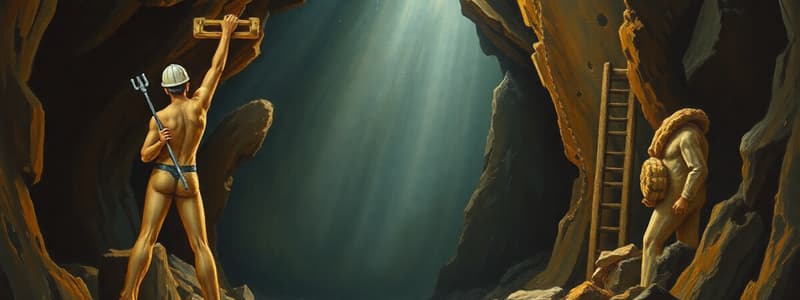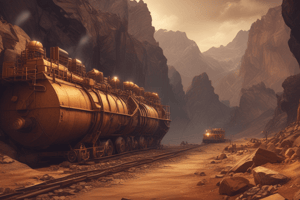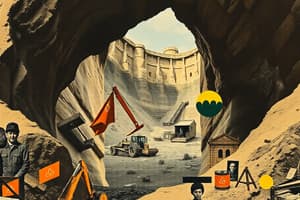Podcast
Questions and Answers
What is the primary purpose of underground development openings in mining?
What is the primary purpose of underground development openings in mining?
- To facilitate the extraction of groundwater
- To serve as storage facilities for equipment
- To ensure safe and efficient access to ore bodies (correct)
- To provide recreation areas for workers
Which of the following factors is NOT considered when determining the mine access method?
Which of the following factors is NOT considered when determining the mine access method?
- The market demand for minerals (correct)
- The depth of the deposit
- The climate
- Geological and hydrological conditions
What is a tertiary or lateral opening in underground mining typically used for?
What is a tertiary or lateral opening in underground mining typically used for?
- Primary extraction of ore
- Internal accessibility for maintenance (correct)
- Haulage and ore transport
- Surface exploration
Which of the following is a critical factor that influences the size of the main access development in a mine?
Which of the following is a critical factor that influences the size of the main access development in a mine?
How can primary underground development openings be beneficial for exploration?
How can primary underground development openings be beneficial for exploration?
What is the key advantage of using a raise boring machine during excavation?
What is the key advantage of using a raise boring machine during excavation?
What is the primary role of a reaming head in the raise boring process?
What is the primary role of a reaming head in the raise boring process?
How does directional drilling enhance the raise boring procedure?
How does directional drilling enhance the raise boring procedure?
What is one of the cost-related characteristics of a raise boring machine?
What is one of the cost-related characteristics of a raise boring machine?
Which safety measure is highlighted as an advantage of raise boring?
Which safety measure is highlighted as an advantage of raise boring?
What was the initial development use of the Alimak raising system?
What was the initial development use of the Alimak raising system?
Which step involves making the excavation safe for personnel using a protective canopy?
Which step involves making the excavation safe for personnel using a protective canopy?
Which of the following is NOT a typical application of Alimak raising?
Which of the following is NOT a typical application of Alimak raising?
What is the primary function of the monorail beam in the Alimak raising system?
What is the primary function of the monorail beam in the Alimak raising system?
During which step is the Alimak climber lowered to a protective station before the blast?
During which step is the Alimak climber lowered to a protective station before the blast?
Flashcards
What are primary mine access openings?
What are primary mine access openings?
Primary openings (e.g., shafts, adits, or slopes/declines/ramps) enable access to the ore body for people and materials.
What are secondary mine access openings?
What are secondary mine access openings?
Secondary openings (e.g., haulage, drifts, or entries) facilitate movement within the ore body, connecting different levels and areas.
What are tertiary mine access openings?
What are tertiary mine access openings?
Tertiary openings (e.g., internal ramps or crosscuts) provide access within specific sections of the ore body.
What factors influence the choice of mine access method?
What factors influence the choice of mine access method?
Signup and view all the flashcards
What factors determine the size of the main access opening?
What factors determine the size of the main access opening?
Signup and view all the flashcards
Raise Boring
Raise Boring
Signup and view all the flashcards
Pilot Hole in Raise Boring
Pilot Hole in Raise Boring
Signup and view all the flashcards
Reaming in Raise Boring
Reaming in Raise Boring
Signup and view all the flashcards
Cuttings Removal in Raise Boring
Cuttings Removal in Raise Boring
Signup and view all the flashcards
Cost-Effectiveness of Raise Boring
Cost-Effectiveness of Raise Boring
Signup and view all the flashcards
Alimak Raising
Alimak Raising
Signup and view all the flashcards
Monorail Beam in Alimak Raising
Monorail Beam in Alimak Raising
Signup and view all the flashcards
Safety During Blasting in Alimak Raising
Safety During Blasting in Alimak Raising
Signup and view all the flashcards
Applications of Alimak Raising
Applications of Alimak Raising
Signup and view all the flashcards
Production Steps in Alimak Raising
Production Steps in Alimak Raising
Signup and view all the flashcards
Study Notes
Mine Access and Development
- Underground mine access is vital for safe, efficient, and economical ore extraction. Access is categorized into primary (main), secondary (level/orebody), and tertiary (lateral/panel) openings.
- Primary openings, like shafts, adits, and declines/slopes, are crucial and must be carefully planned early in the mine life.
- Key decisions include type, number, shape, and dimensions of primary openings, which are greatly affected by:
- Deposit size, shape, and depth
- Surface terrain
- Geology (orebody and surrounding rock)
- Mining method and production rate
- Climate
- Infrastructure
- Regulations
- Environmental concerns
- Size of main openings is influenced by:
- Ventilation needs
- Daily tonnage hoisted
- Mobile equipment size
- Number of personnel
- Required services (power, water, air).
- Primary openings can serve an explorative function, offering crucial information before full-scale mining. Exploration often precedes mining
- Underground mines are preferred when open-pit mining is uneconomical due to depth or when ore bodies were previously mined at surface.
- Raise Boring: A method for creating vertical or inclined shafts between levels. Access is required at both ends.
- A pilot hole is initially drilled downwards using a raise boring machine.
- The raise-boring machine is then used to ream the hole to the required diameter, rotating the reaming head upwards towards the fixed machine at the start of the pilot hole.
- Cuttings fall to the lower level and are removed by safe methods (e.g., remote control).
- Raise boring is advantageous due to capital cost (which is relatively high), but it has a good ROI for longer shafts. Other benefits include no miner presence during the excavation process, continuous operation, no explosives, smooth and stable profile, and reduced manpower. However, the most critical advantage is safety.
- Alimak Raising: An alternative to raise boring, safer than conventional raise development. Suitable for ore-passes, short raises, and short shafts, especially with only bottom access. Requires vertical or steep dipping excavations.
- Developed in 1957 for high-rise building construction.
- Applications include ventilation raises, stope slot raises (for longhole open stopes), ore/waste pass systems, raise bore rehabilitation, ventilation shafts, manway raises, and emergency ladder way installations.
- Alimak Raise Climbers are available with air, electric, or diesel/hydraulic drive units. A 1,050m-long shaft was driven in one step in Norway.
- Platforms can vary in shape and size, with the largest supplied exceeding 30m².
- A movable working platform running on a monorail beam. Improves productivity and safety. The monorail track lengthens with sections added and bolted to excavation sidewalls.
- Five production steps, using a raise climber:
- Scale: Make safe area around personnel cage (with canopy).
- Drill: From the drill deck on top of the climber, sized for the raise.
- Charge: After drilling, charge the face with explosives.
- Blast: Lower climber to the bottom, into a station for protection, before remotely triggering the blast. Rail remains protected.
- Ventilate and remove: Effectively ventilate and remove broken ore from the excavation bottom, preparing for re-entry.
Studying That Suits You
Use AI to generate personalized quizzes and flashcards to suit your learning preferences.




